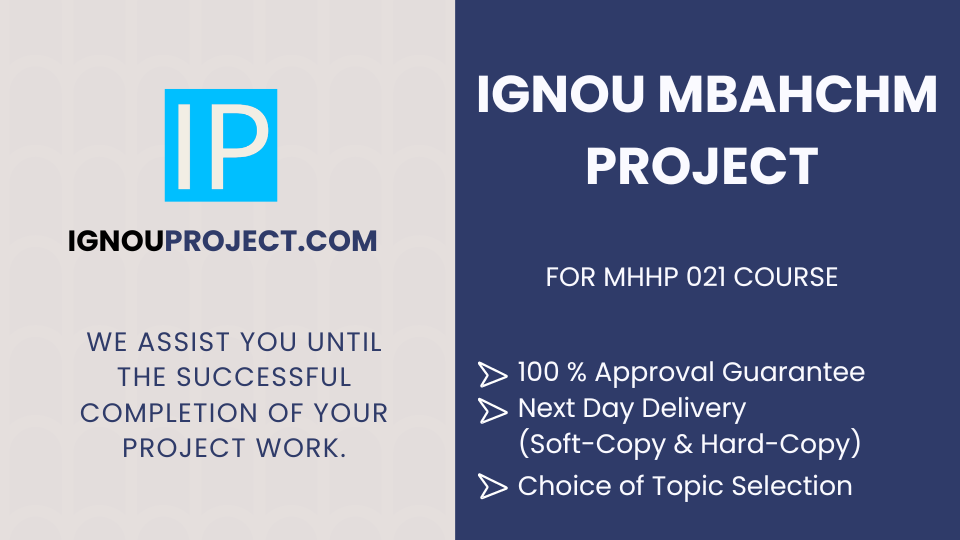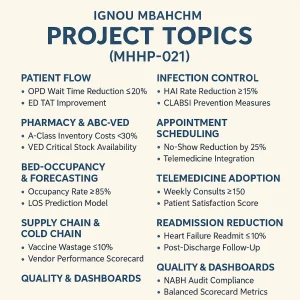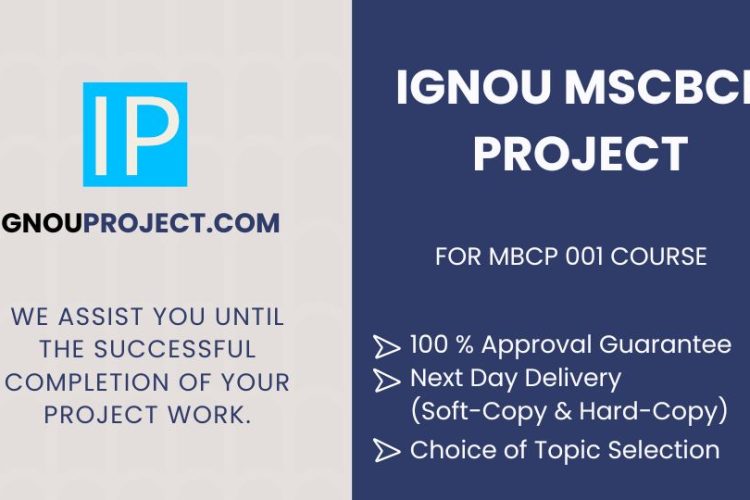
The IGNOU MBAHCHM Project (MHHP 021) stands for the course of Master of Business Administration in Health Care and Hospital Management. IGNOU MBAHCHM Project (MHHP 021) designed to provide students with the opportunity to apply theoretical knowledge to practical scenarios in the field of hospital and healthcare management.
The MHHP-021 project is the capstone of IGNOU’s MBA (Hospital & Healthcare Management), designed to test how well you can apply operations, quality, and policy concepts to real healthcare settings. This guide helps you start strong: it explains how to choose a practical, data-ready topic (patient flow, infection control, pharmacy ABC-VED, bed-occupancy forecasting, etc.), frame clear objectives and KPIs, and follow the IGNOU-approved report format from title page to annexures.
Whatsapp us to get the Personalized (Customized) IGNOU MBAHCHM Project Report and Synopsis
Download PDF Link for IGNOU MBAHCHM Project for MHHP 021
IGNOU MBAHCHM Project Topics (MHHP 021)
- Impact of Technology on Healthcare Delivery
- Study the impact of recent healthcare policies on hospital management and patient care
- Study the methods used by hospitals to engage patients and improve satisfaction.
- Training and Development in Healthcare: Investigate the training and professional development opportunities for healthcare workers.
- Strategies to Improve Patient Safety: Investigate the measures taken by hospitals to enhance patient safety and reduce medical errors.

Image: Project Topics for IGNOU MBAHCHM (MHHP 021)
What should be included in the IGNOU MBAHCHM Project Proposal (MHHP 021)?
Your MBAHCHM project proposal should include:
- A concise title
- An introduction with background and rationale
- Clear objectives
- A detailed methodology
- Expected outcomes
How do you choose a relevant and impactful topic for your IGNOU MBAHCHM Project (MHHP 021)?
Steps to Choose a Relevant and Impactful Topic for MBAHCHM project:
Identify Your Interests:
Consider the areas of hospital and healthcare management that interest you the most. This could be anything from healthcare policies, patient care management, hospital administration, health informatics, or public health issues.
Review Course Materials:
Go through your course materials, including textbooks, lecture notes, and assignments. Identify topics that you found intriguing or areas where you feel more research is needed.
Conduct Preliminary Research:
Perform a preliminary literature review to identify current trends and gaps in hospital and healthcare management research. Look for recent studies, articles, and reports in academic journals and industry publications.
Consider Practical Implications:
Choose a topic that has practical implications and can contribute to the field of hospital and healthcare management. Consider how your research can address real-world problems or improve existing practices.
Consult with Practitioners:
Speak with healthcare professionals, hospital administrators, and other practitioners to gain insights into current challenges and opportunities in the field. Their practical experience can help you identify relevant topics.
Assess Feasibility:
Ensure that the topic you choose is feasible in terms of data availability, time, and resources. Consider whether you can access the necessary data and whether the project scope is manageable within the given timeframe.
Seek Supervisor Guidance:
Discuss potential topics with your supervisor or mentor. They can provide valuable feedback on the relevance and impact of your chosen topic and help you refine your research question.
Align with Career Goals:
Choose a topic that aligns with your career goals and interests. This will not only keep you motivated throughout the project but also enhance your expertise in a specific area of hospital and healthcare management.
Narrow Down Your Focus:
Once you have a broad area of interest, narrow it down to a specific research question or problem. A focused topic will allow you to conduct a more in-depth study and provide clearer conclusions.
Consider Ethical Implications:
Ensure that your research topic and methodology adhere to ethical guidelines. Consider the ethical implications of your study, especially if it involves patient data or interactions with healthcare providers.
Note: If you’re unsure, you can read our guide on how to select IGNOU MBA Project Topic.
How detailed should the methodology be in an IGNOU MBAHCHM proposal?
The methodology section of your project proposal should be detailed enough to clearly convey how you plan to conduct your MBAHCHM research. It should provide a comprehensive plan that outlines the research design, data collection methods, and analysis techniques you will use. Here’s a guide on what to include in the methodology section and how detailed it should be:
Research Design:
- Type of Study: Specify whether your study is qualitative, quantitative, or mixed-methods. Explain why this approach is suitable for your research question.
- Framework: Outline the theoretical or conceptual framework that guides your research.
Population and Sample:
- Population: Describe the population you will study, including relevant characteristics (e.g., demographics, location).
- Sampling Method: Explain the sampling method you will use (e.g., random sampling, stratified sampling). Justify why this method is appropriate.
- Sample Size: State the estimated sample size and justify why this size is sufficient to achieve reliable results.
Data Collection Methods:
- Primary Data: Describe the primary data collection methods you will use (e.g., surveys, interviews, observations). Include details about the tools or instruments you will use (e.g., questionnaires, interview guides).
- Secondary Data: If applicable, describe any secondary data sources you will use (e.g., existing records, published studies).
- Data Collection Process: Provide a step-by-step plan for how you will collect data, including timelines and procedures for gaining access to participants or data sources.
Data Analysis Techniques:
- Qualitative Analysis: If applicable, describe the qualitative analysis techniques you will use (e.g., thematic analysis, content analysis). Explain how you will code and interpret qualitative data.
- Quantitative Analysis: If applicable, describe the quantitative analysis techniques you will use (e.g., statistical tests, regression analysis). Specify any software tools you will use (e.g., SPSS, Excel).
Ethical Considerations:
- Ethical Approval: Explain how you will obtain ethical approval for your study, if required.
- Informed Consent: Describe how you will obtain informed consent from participants.
- Confidentiality: Explain how you will ensure the confidentiality and anonymity of participants.
Limitations and Delimitations:
- Limitations: Acknowledge any potential limitations of your study (e.g., sample size constraints, data collection challenges) and how you plan to address them.
- Delimitations: Define the boundaries of your study (e.g., specific populations, locations, time frames) and justify these choices.
How to present findings & discussion in the IGNOU MBAHCHM project?
Presenting your findings and discussion effectively is crucial to conveying the significance and implications of your IGNOU MBAHCHM Project (MHHP 021) research. Here’s a detailed guide on how to structure and present these sections in your MHHP 21 project report:
Findings Section
Introduction to Findings:
- Briefly restate the research objectives or questions to remind readers of the purpose of your study.
- Outline the structure of the findings section, indicating what will be covered.
Presentation of Data:
Quantitative Data:
- Use tables, charts, and graphs to present numerical data clearly.
- Include descriptive statistics (e.g., mean, median, standard deviation) to summarize the data.
- Highlight key patterns, trends, and relationships.
Qualitative Data:
- Present themes or categories that emerged from the data analysis.
- Use quotes or excerpts from interviews, focus groups, or open-ended survey responses to illustrate these themes.
Organize by Research Questions or Hypotheses:
- Structure your findings around the research questions or hypotheses.
- Ensure each subsection addresses a specific question or hypothesis.
Clear and Concise Presentation:
- Avoid overwhelming the reader with too much data. Focus on the most relevant and significant findings.
- Use bullet points or numbered lists for clarity and brevity where appropriate.
Visual Aids:
- Ensure all visual aids (graphs, tables, charts) are clearly labeled with titles, axis labels, and legends.
- Refer to each visual aid in the text, explaining its relevance and what it shows.
Discussion Section
Introduction to Discussion:
- Briefly summarize the main findings of your study.
- Explain the structure of the discussion section.
Interpretation of Findings:
- Discuss what the findings mean in the context of your research questions or hypotheses.
- Explain any unexpected results and provide possible reasons for them.
Comparison with Existing Literature:
- Compare your findings with those of previous studies.
- Highlight agreements, contradictions, and gaps in the literature.
- Explain how your study contributes to the existing body of knowledge.
Implications of the Findings:
- Theoretical Implications: Discuss how your findings contribute to theoretical frameworks or models in hospital and healthcare management.
- Practical Implications: Explain the practical applications of your findings for healthcare managers, policymakers, practitioners, or other stakeholders.
- Policy Implications: Suggest any changes or recommendations for healthcare policies based on your findings.
Limitations of the Study:
- Acknowledge the limitations of your study, such as sample size, data collection methods, or potential biases.
- Discuss how these limitations might affect the interpretation of your findings.
- Recommendations for Future Research:
- Suggest areas for further research that could address the limitations of your study or explore new questions raised by your findings.
- Provide specific and actionable recommendations for future researchers.
Conclusion of Discussion:
- Summarize the key points discussed.
- Reiterate the significance of your findings and their contributions to the field.
How is the IGNOU MBAHCHM Project (MHHP 021) evaluated?
The MBAHCHM project is evaluated based on:
- Relevance and originality of the topic
- Rigor of the research methodology
- Depth of data analysis and interpretation
- Quality of report presentation
- Practical implications of the findings
IGNOU MBAHCHM Project Report Submission Process
The process for submitting the final project report for the IGNOU MBAHCHM Project typically involves several key steps. Here’s a detailed guide to help you navigate the submission process:
1. Completion and Review of the Project Report
- Writing and Formatting: Ensure your MBAHCHM project report is complete, well-organized, and formatted according to the IGNOU’s project guidelines.
- Proofreading and Editing: Proofread your report for any grammatical errors, typos, and formatting issues. Consider seeking feedback from peers or a mentor.
2. Preparation of Required Documents
- Title Page: Include the title of your project, your name, enrollment number, program code (MHHP-021), and other relevant details as per the guidelines.
- Certificate of Authenticity: This certificate should be signed by you and your project supervisor, stating that the work is original and has not been submitted elsewhere.
- Project Approval Form: Include a copy of the project approval form that was signed by your supervisor and approved by the university.
- Abstract: A brief summary of your project, usually one page, highlighting the objectives, methodology, findings, and conclusions.
3. Binding the Project Report
- Hard Copy: Bind your project report according to the specifications provided by IGNOU, usually in a spiral or hard binding with a transparent front cover.
- Digital Copy: Prepare a digital copy (PDF) of your project report, ensuring it includes all the required sections and is properly formatted.
4. Submission to the Study Center
- Submission Deadlines: Be aware of the submission deadlines for your MBAHCHM project report. Ensure you submit both the hard and digital copies on time.
- Number of Copies: Submit the required number of copies of your project report. Typically, this includes one copy for the study center and one for your records.
- Receipt: Obtain a receipt or acknowledgment from the study center confirming the submission of your project report.
5. Online Submission (if applicable)
- Online Platform: Some programs may require or allow for online submission of the project report. Check if there is an online submission platform or email address provided by IGNOU.
- File Naming and Upload: Name your file according to the MBA project guidelines (e.g., EnrollmentNumber_ProjectTitle_MHHP-021.pdf) and upload it to the designated platform or email it as instructed.
6. Follow-Up
- Confirmation: Follow up with the study center or your supervisor to ensure that your MBAHCHM project report has been received and is being processed.
- Evaluation Process: Inquire about the evaluation process and timelines. Understand when and how you will receive feedback or grades for your project report.
7. Post-Submission
- Revisions (if any): Be prepared to make any revisions if required by the evaluators. Submit the revised report within the stipulated time.
- Documentation: Keep copies of all correspondence, submission receipts, and feedback for your records.
Must Read: IGNOU MBA Project Submission.
FAQs – IGNOU MBAHCHM Project (MHHP-021)
Who is eligible to submit MHHP-021?
Learners enrolled in the MBA (Hospital & Healthcare Management) who have completed the required courses and have a valid registration during the submission cycle.
How do I select a topic for my MBAHCHM Project?
Pick a healthcare operations/service topic with measurable KPIs (quality, cost, patient flow, infection control, supply chain, etc.), feasible data access (6–12 weeks or 150+ records), and ethical clearance if needed.
What permissions are required for hospital data?
Written permission from the hospital/clinic/diagnostic center. For patient data, anonymize identifiers and attach a consent/permission letter in annexures.
What analysis methods fit healthcare ops?
Descriptives, control charts (infection/defect rates), ABC-VED for pharmacy, forecasting (OPD/bed occupancy), queueing for OPD/lab, capacity/utilization/OEE, DMAIC/Lean for process improvement.
Can I collaborate with a hospital if I’m not employed there?
Yes—approach as a student researcher with an official letter, define data to be used, confidentiality terms, and deliverables.
Do I need a problem statement and KPIs?
Absolutely. Define baseline KPIs (e.g., wait time, bed occupancy, defect rate, stockouts) and set target improvements.
Downloadable Resources:
- IGNOU MBAHCHM Project Synopsis Sample PDF
- IGNOU MHHP 021 Project Report Format PDF
- Approved IGNOU MBAHCHM Project Topics List
Need Expert Help in your IGNOU MBAHCHM Project?
WhatsApp us and get your MHHP 021 project written to your specifications, synopsis checked, and your viva preparations all without plagiarisms at www.ignouproject.com!

